Klub Max dancefloor circa 1994. Photo by Steven Lungley. All rights reserved.
Article originally published January 19, 2012 by The Grid online (TheGridTO.com).
Denise Benson revisits the three-storey super-club that was at the epicentre of Toronto’s early ‘90s Entertainment District explosion.
BY: DENISE BENSON
Club: Klub Max, 52 Peter (now 56 Blue Jays Way)
Years in operation: 1990-1994
History: This is a tale of a changing Toronto. It tells the story of an historic area in transition, mere years before it came to serve as the meeting point for the touristy and the trendy. Also at its centre is a man who became one of this city’s most successful nightlife entrepreneurs, as well as a number of our most recognized DJs.
52 Peter Street was once the George Crookshank House. Built in the 1830s, it’s one of the street’s oldest buildings and was designated an historic site under the Ontario Heritage Act. But its beautiful brick frontage would be obscured by modern smoked glass and signage when Nick Di Donato and his Liberty Entertainment Group renovated it extensively at the end of the 1980s to open, at first, a single-level P.M. Toronto sports bar and restaurant.
In 1990, Di Donato and colleague Angelo Belluz developed the property into the area’s first full-on dance club—a three-floor funhouse named Klub Max. It took vision—and nerve—to open a large club there at the time.
“This was an industrial area where there were large vacant spaces—very industrial commercial spaces and no residential,” recalls Di Donato. “It was a perfect club area. The proximity to SkyDome also provided an influx of people on game and concert nights, as well as post-event parties.
“I was inspired by the club scene in New York City’s Meatpacking District, like Mars Club, and wanted to bring that energy to Toronto,” he explains. “Klub Max was one of only three clubs in the city with a capacity of over 1,100.”
Why it was important: Sandwiched between a Don Cherry’s Grapevine on its north end and a restaurant-cum-karaoke bar to its south (Wayne Gretzky’s restaurant didn’t open across the street until 1993), Klub Max was not certifiably cool or fashionable, but it was genuinely interesting. It was a club where suburbanites and downtowners of varying ages met on the dancefloor, largely thanks to the decidedly different musical formats found within.
“Klub Max was an industry leader,” says Di Donato. “It was one of the city’s first multi-level clubs; in essence, it was three clubs in one, targeting an audience of diverse music preferences, but with a desire to be in a large club atmosphere. People loved to move from one room to another, experiencing a different vibe and sound in each.”
With Di Donato and Belluz initially at its helm, Klub Max featured rock and alternative on its third tier; dance music pounded out of the main floor’s massive soundsystem; and the basement ranged from grunge to rave to hip-hop, depending on night.
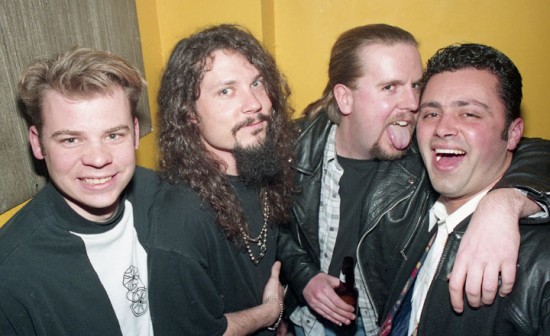
Chris Pack (CFNY producer), Martin Streek (CFNY DJ), “Brother Bill” (CFNY DJ) and Angelo Belluz (Klub Max co-owner). Photo by Steven Lungley (http://stevenlungley.com/)
“This club was my first foray into the large nightclub business, and it was where I gained my experience to develop one of Toronto’s longest-running nightclubs, The Phoenix Concert Theatre,” emphasizes Di Donato, now President and CEO of Liberty Entertainment Group.
Di Donato left Klub Max to open The Phoenix as a live concert space and dance club in November of 1992. Angelo Gerardi and Tony Antonucci bought him out to join Belluz in developing Max.
It’s interesting to note that the majority of DJs I spoke with—including some who began spinning at Max as far back as 1990-1991—did not meet Di Donato until years later, when he and brother Pat hired them to play at subsequent Liberty Group ventures. No matter. What is clear is that many now big-name Toronto DJs got their start—or firmed up their followings—at Klub Max. In its early years, especially, the venue had an underground vibe.
One of the most-discussed Max events to this day is Deep Forest, an all-ages Sunday party that ran in the summers of 1990 through 1993. That’s where a teenage DJ Tricky Moreira got his professional start, initially playing alongside DJ Tin-Tin, and then later with Neil & Cain, on the main floor while the Red Flame crew rinsed reggae upstairs and DJX bumped hip-hop in the basement. Go-go dancers did their thing against the black-and-silver décor while house and techno lovers slid across a stainless steel dancefloor in their bellbottomed pants. The night was enormously popular from its start.
“I was blown away the first night” recalls Moreira. “Tin-Tin and I decided to get to the club for about 7 p.m. to make sure everything was set up properly. When we arrived, there were literally hundreds of people, in the evening summer sun, waiting in line for the club’s doors to open. When the doors opened at 9 p.m., there was a rush to enter. After getting past the front door, you’d have to climb up a row of steps leading into the main room, with the DJ booth located above the dance floor for all to see. The energy was beyond impressive.
“The house we played was very new, very experimental,” continues Moreira, who would go on to find fame as a DJ, producer and radio host. “It’s the stuff that’s now coined ‘classic house,’ but for us it was the newest of the new—stuff like Raze’s ‘Break 4 Love,’ Ten City’s ‘That’s The Way Love Is,’ to the harder, more techno-driven sounds like Mike Dunn’s ‘Magic Feet.’ Max was an avenue for deeper underground electronic music, situated around the early warehouse, pre-rave days. Max left a new impression. Being as young as we were, it was our Studio 54.”
Klub Max was also where CFNY personality and DJ “Deadly” Hedley Jones (pictured above) hosted his All Night Dance Party. Broadcast live-to-air on Saturdays, midnight-to-6 a.m. from 1990-1994, the program was the only one on commercial radio to explore the intersection of house, hip-hop, reggae and rave.
“I think the crowd at Klub Max was a mix of all of those genres,” recalls Jones. “They really came to dance and listen to music, which was always fresh. They knew if they came out they were going to hear it there first. Carnival Records and Play De Record—the hot shops at the time—would sell out many of the tracks I played the next day.
“I was playing a lot of white labels and dubplates,” adds the influential and industrious broadcaster, then known as the “late-night guy” on CFNY (now 102.1 the Edge). “Max was unique in that, even though the club closed its doors at 3 a.m., people had the choice to stay until the show ended. I had out-of-town guests and DJs visiting all the time. It was a great hang out.”
“It was the most exclusive after-party I can remember,” adds DJ Mark Oliver who played “stomping, up-front house music” Fridays and Saturdays at Max from 1991-1993, including as an integral part of Hedley’s live-to-air.
“We would have a howl, playing test presses of all the latest gems without having to keep an eye on the dancefloor,” says Oliver, who, at the time, was already a rave headliner also known for his nights at Go-Go and beloved Acid Jazz Wednesdays at The Cameron House. “I could never really get my head around the fact that, at 4 a.m., we were playing to a handful of Hedley’s mates in the club, but tens of thousands of punters were listening on the radio.”
“The crowd was always up for it, jumping and screaming all night,” he recalls. “The atmosphere was very much like a rave. I played many of the same tracks I would have played at raves, but the Max faithful were not dressed like ravers. At that time, most regular-hours, licensed clubs around town were meat markets playing Top 40. I would say that Max unknowingly provided an alternative. Between the insanely loud and crisp sound system and the rammed dancefloor, it would have been a challenge to chat someone up.”
Who else played there: While dozens of DJs passed through Klub Max’s three different booths over the years, a few other names are mentioned repeatedly by those interviewed here. Jason “Deko” Steele was an early main-room resident, introducing dancers to house music while also releasing music on influential local labels including Hi-Bias. Other dance music DJs included Terry Kelly, Matt C, James St. Bass and Peter, Tyrone and Shams, while people like DJ Gary, Craig Beesack, Michael X and Cam brought the alternative.
“DJ Gio [Cristiano] was our Rock God,” says Nick Di Donato of the weekend resident DJ who had worked for him previously at P.M. Toronto.
“There were a lot of smashed glasses everywhere,” says Cristiano (who went on to play at many Liberty Group venues) of the vibe on Saturdays at Klub Max.
Most memorable moments: “I’ll never forget the night the Jays first won the World Series [in 1992],” shares Oliver. “The club installed a huge screen for everyone to watch the game, without audio, while dancing. Tapping into the already electric energy of the crowd, I created a soundtrack on the fly, doing things like syncopating beats with Joe Carter’s warm-up swings of the bat. You could throw a stone from Max and hit SkyDome, so when the World Series was captured, you can imagine the images that followed. Max suddenly became a bunker, the safest place to be on Peter Street. The club couldn’t even open its doors to let anyone in; it would have been like opening your sunroof during a hail storm.”
The Blue Jays’ victory also prompted Toronto City Council to rename Peter Street south of King as Blue Jays Way in 1992. (How the building Klub Max was in shifted from 52 Peter to 56 Blue Jays Way is a mystery I haven’t been able to crack.)
Oliver has a number of great stories from his time at Max, which ended when he moved back to Scotland for a stretch in 1993.
“I remember an odd night when I bumped into Moby hanging by himself in the basement of the club,” says Oliver. “He was huge in the underground rave scene at the time with ‘Go,’ but hadn’t put out an album or hit the mainstream yet, so he was just another guy in the crowd. When I asked him what brought him to Klub Max, he said he was in town, hanging out with his pen-pal from when he was a young boy.”
What happened to it: “Klub Max closed down one year after I sold it,” recalls Di Donato, who then opened not just The Phoenix, but also Joker, Left Bank, The Rosewater, Courthouse, Tattoo Rock Parlour (with Charles Khabouth), the Liberty Grand Entertainment Complex and many other businesses.
His timeline is a little off however, as Klub Max did not officially close in 1993 according to most. It closed for a period and was heavily renovated in early 1994, with Belluz, Gerardi and Antonucci as owners. Former Klub Max customer and bartender Mary Ireton recalls that the venue was “given a pyramid look” and re-born as a club called 3000 BC. It closed later that year.
56 Blue Jays Way eventually became a Second City and then the Diesel Playhouse. The area itself, of course, exploded with nightclubs in the mid-1990s. After years of speculation, we now know that the address will become the 41-storey Bisha Hotel and Residences. A project of Charles Khabouth’s INK Entertainment and Lifetime Developments, the boutique-spot-to-be will feature the interior design of one Lenny Kravitz.
Mark Oliver, now one of Toronto best-known DJs, credits Max as his “first foray into DJing at a more mainstream venue” and thus a “programming blueprint for venues such as The Guvernment,” where he has reigned as resident DJ of Spin Saturdays since 1996.
Tricky Moreira continues to tour, make music and DJ on home turf, including at his Big DJ, Small Club series.
Hedley Jones moved to Los Angeles in 2002 and DJs occasionally, but is focused on his career as a photographer.
Gio Cristiano is now known for spinning electronic dance music, including at The Mod Club’s UK Underground Saturdays.
Thank you to all interviewed above, as well as to Alex Dordevic, Rob Duffy, Mary Ireton, James St. Bass, James Applegath, Patrick Whyte, Adrienne Cauchi and Stacey Hawkins of Liberty Entertainment Group, and photographer Steven Lungley.

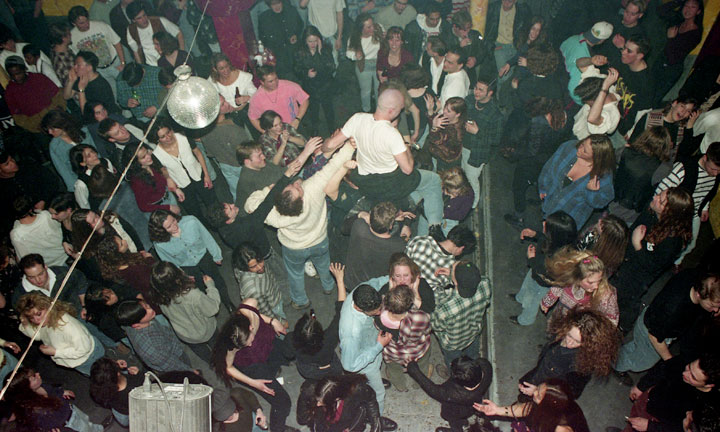
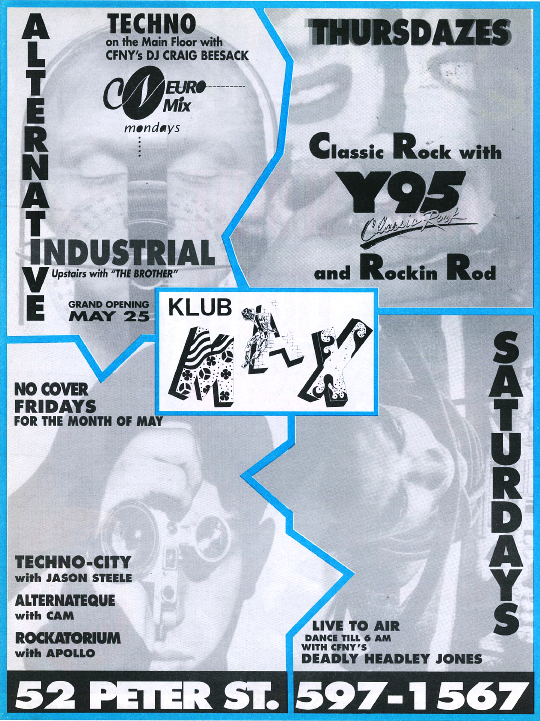
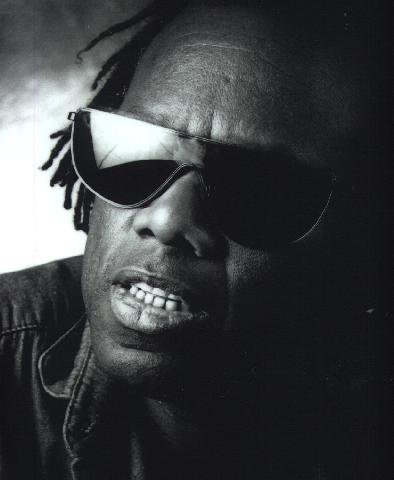
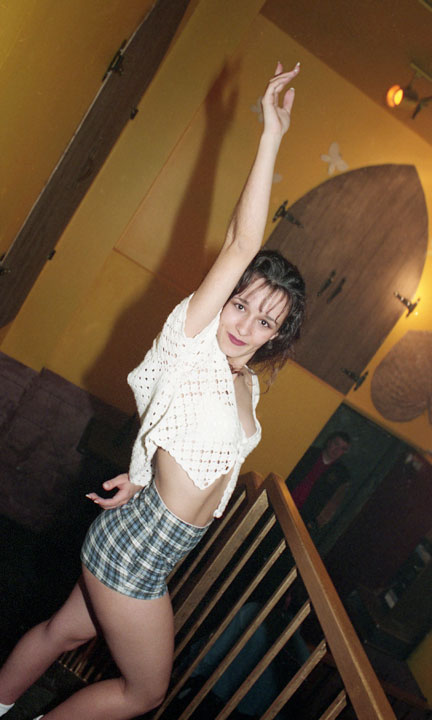
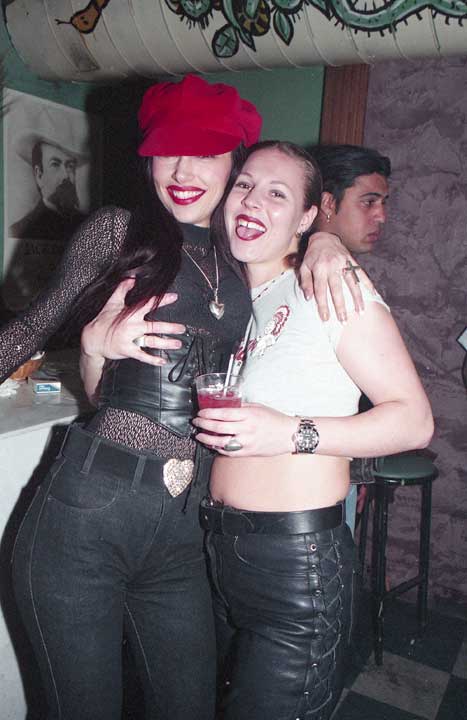
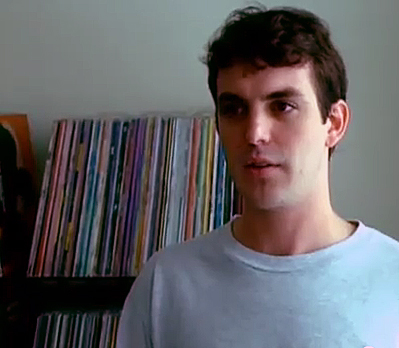
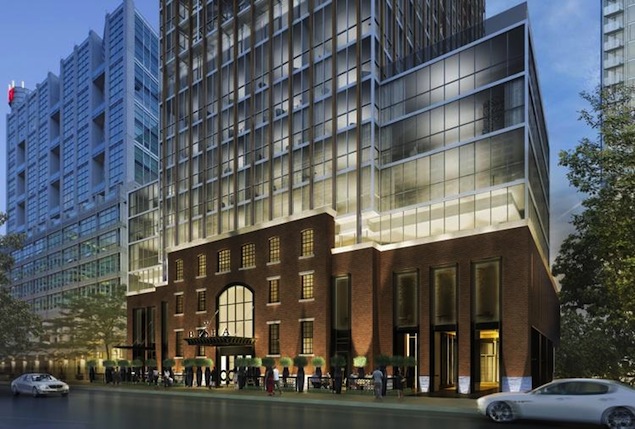
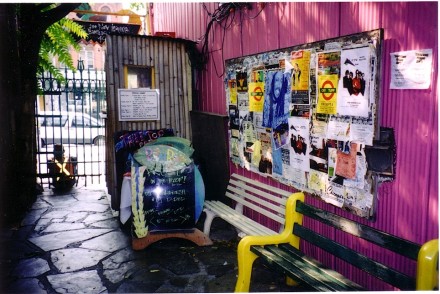
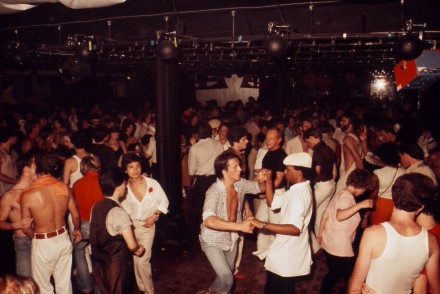
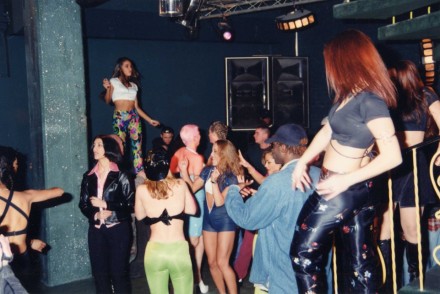

1 Comment
All comments in the string below have been republished from their original appearance on The Grid website. We’re including the readers’ comments as they add to these Then & Now stories. We look forward to reading new comments here as well.
ron
I can tell you it was a fun joint to be at , i remember my saturdays use to be we would go to dinner early then chill at a local bar before heading over to Max around 11:40pm, and stay there until 5:30 .then we all would head off to golden griddle for breakfast , those were truly good times, And i do have my MAX VIP pass as a souvenir..lol 3:18 am on October 4, 2013
victoria
Omg I loved this club! Hung out here for many years every weekend. Had a huge crush on Tek the bouncher. So many great times & great memories spent there. Used to love club RPM as well with dj Chris Sheppard!  8:25 am on June 18, 2013
Jason Paris
Great piece! Klub Max and The Phoenix were actually my first two Toronto clubs, so this piece was yet another “memory lane” in a great series. Nitpicking, but Peter Street was renamed Blue Jays Way on a request from Wayne Gretzky hiimself. He wanted his bar to have an address of 99 Blue Jays Way (instead of 99 Peter St). I’m sure the Blue Jays early-90s success played a role too, but it was acutally The Great One. 11:40 am on July 6, 2012
Jerome
This was my first regular club. I was madly in love with Caroline the downstairs bartender. 4:44 pm on January 23, 2012
iSkyscraper
Mars Bar was in the East Village, not the Meatpacking District. There was no Meatpacking District in fact in 1990. But whatever, the point was to bring some of the New York club vibe to Toronto. Fittingly, big night clubs then died off in New York shortly after 2000 and the last of them met the same fate in Toronto a few years later. 1:06 pm on January 21, 2012
johnAndrew
Mars Bar was a bar in the East Village, BUT Rudolf Piper’s Mars Club was on West Side Highway in the West Village. It was multi-leveled so when Nick talks about being influenced by Mars Club he is correct. And Moby got his start as a NY DJ on the rooftop in a weekly event called Moby Decks. I know this because I did the photo of Rudolf and then girlfriend for the opening night invite. Rudolf was the mastermind behind NY’s Danceteria and the Tunnel and Quick and Mars Club. The Tunnel is where Michael Alig and the club kids started, in the basement (unlike the movie Party Monster that ignores Rudolf and talks about Peter Gatien and the basement of the Limelight…based on a true story but actually fiction). It was Rudolf who jump-started the club kid scene in 1987 and Pete Gatien didn’t get involved with Alig until late 1990 when Alig’s Disco 2000 opened at Limelight. It was Rudolf who underwrote Alig’s Project X magazine for the first three years and not Gatien. I know this because I was Chief Photographer for Project X for the same period. http://johnsimone.ca/john-simones-new-york-period.php 9:25 am on February 9, 2013
DJ Michael X
Wow, again, great story Denise. I spun at Max for a long time as well, all 3 floors on different occasions, so it’s nice to read your story and remember the early days of Toronto’s ‘Club District’. I wonder what would have happened to the TO vibe if venues like this didn’t exist in the 90′s… Oops. I forgot. it would have ended up like TO 2012. Thanks again Denise. ps. I hope I can stir your creative juices and get a story about Freakshow or at least 318 Richmond St. Classic Toronto club story. 2:29 am on January 21, 2012
Barbarella
I was just going to comment that I hadn’t seen Michael X’s name in this article!  Personally, Michael was the reason I went to Klub Max. One of my top fave 90′s DJ’s. He’s also the reason I went to Go Go + Boom Boom Room [in addition to DJ Shannon + Bartender extraordinaire Deanna at Boom!]. Loving these old club stories, Denise. Awesome memories. Please keep ‘em coming! 12:22 am on February 7, 2012
P
I remember this club but by then I’d seen the best club in Nightclub land history and it was Go-Go’s. The white Room in the basement had some of the best NYC underground house DJs as guests and each of its 4 floors had its own vibe including rock in the black room. With Still Life across the street and RPM for Monday night Rock, this town was peaking for clubs..I could go on and on. I was in clubs 5 days a week and every club had its own genuinely different vibe..NOTHING like today where it’s one big homogenous blob of pop-goop. 10:36 pm on January 20, 2012
Bmorales
Being 17 at the time, Klub Maxx was our Sunday night mass and our krew went religiously. Till this day, best damn club I’ve been to in Toronto. Some NYC, LA, & DC clubs come close but back then, it was genius with 3 floors of bumpn’ beats and fun peeps. Tricky was money on that quote (it was our Studio 54). We did wait in line because it was packed inside, not like these fools now who hold the line to make it look/feel busy, when its not. Thx for the memories – Back in the day, when i was young…. Bee 10:22 pm on January 20, 2012
Aliwanwan
I loved Klub Max! It was probably the first club I had ever been to and it helped start my love for multi-level clubs. I was straddling between top-40, house and alternative so I was able to get some of my fix and their $3-4 Maximum Ice beer!! I do feel old but I also feel blessed to have gone clubbing before the Entertainment District became douchebag central. 4:53 pm on January 20, 2012
Bigg Moe Caesar
Wow, This article makes me feel old! I remember working at Maxx and then Baseline in those days. There will be no other like it, Clubs nowadays are too superficial! Funny nomention of Wanda in the article! 12:34 pm on January 19, 2012
fattyp
I would take the bus, RT, subway and streetcar to get to Klub Max all the way from Malvern (east scarborough). I remember the small, green, business-card sized flyers for Deep Forest and spent many Sunday nights there over the few years the night ran. Seeing those pics brought back a flood of memories. Anyone else there the night punks shot up the place after getting into an spat with Grant (the manager)? 11:57 am on January 19, 2012
Ken
Ever had a song that for years would get stuck in your head but you could never remember the Title or Artist? Yeah Mike Dunn – Magic Feet. Even today that song will pop into my head and get stuck there. Thanks for finally putting a title to the madness!! Incidentally I loved the 3 floors of Max, Friday Nights in the early 90′s I could go with any group of friends I wanted and have a great time. 10:47 am on January 19, 2012